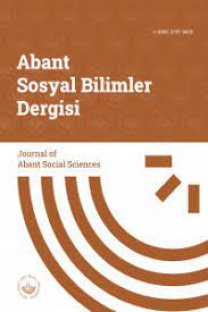Mavi Sukuk: Bir Model Önerisi ve Potansiyeli
Mavi ekonomi, okyanus ekonomisi, mavi tahvil, sukuk, mavi sukuk
Blue Sukuk: A Model Proposal and Its Potential
Blue economy, ocean economy, blue bond, sukuk, blue sukuk,
___
- AAOIFI (2004), Shari’ah Standard No. (17) Investment Sukuk, https://aaoifi.com/ss-17-investment-sukuk/?lang=en, (Erişim Tarihi: 20.08.2023).
- ADB (2021a), Sovereign Blue Bonds Quick Start Guide, https://www.adb.org/sites/default/files/publication/731026/adb-sovereign-blue-bonds-start-guide.pdf, (Erişim Tarihi: 20.08.2023).
- ADB (2021b), Green and Blue Bond Framework, https://www.adb.org/sites/default/files/publication/731026/adb-green-blue-bond-framework.pdf, (Erişim Tarihi: 20.03.2023).
- Adil, M., Hoogendoorn, H. J. ve Jumat Z. H. (2023), Sukuk Innovation: Powering Sustainable Finance, Z. H. Jumat, S. H. Khateeb ve S. N. Ali (Eds), Islamic Finance, FinTech, and the Road to Sustainability Reframing the Approach in the Post-Pandemic Era, (s. 145-158), Switzerland: Palgrave Macmillan.
- Bosmans, P. ve Mariz, F. (2023), The Blue Bond Market: A Catalyst for Ocean and Water Financing, Journal of Risk and Financial Management, 16(3), s.1-48.
- Buana, G. K. (2020), Bridging Islamic finance and SDGs Impact Investing Through Sukuk, https://gregetkallabuana.medium.com/bridging-islamic-finance-and-sdgs-impact-investing-through-sukuk-93c8bb6ff70a, (Erişim Tarihi: 15.03.2023).
- Clifford Chance (2019), Blue Bonds Expanding to The Oceans, https://www.cliffordchance.com/content/dam/cliffordchance/briefings/2019/11/blue-bonds-expanding-to-the-oceans.pdf, (Erişim Tarihi: 20.03.2023).
- European Union (2021), Sustainability Criteria for The Blue Economy Main Report, Luxembourg: Publications Office of the European Union.
- Gulf Times (2017), Innovative Approach in Islamic Finance: Hybrid Sukuk Issue, https://www.gulf-times.com/story/542266/innovative-approach-in-islamic-finance-hybrid-sukuk-issue, (Erişim Tarihi: 20.08.2023).
- Huang, M. ve Morgan P. J. (2022), Overview of the Blue Economy and Blue Finance, P. J. Morgan, M. C. Huang, M. Voyer, D. Benzaken ve A. Watanabe (Eds), Blue Economy and Blue Finance Toward Sustainable Development and Ocean Governance, (s. 1-7), Japan: Asian Development Bank Institute.
- IIFM (2022), IIFM Sukuk Report A Comprehensive Study Of The Global Sukuk Market. https://www.iifm.net/frontend/general-documents/b387b56a6a4c664ff1fa2bc16f2ef1be1662443654.pdf, (Erişim Tarihi: 20.03.2023).
- Maulana, A. ve Zahro F. (2021), Blue Sukuk as A Solution to Indonesia Maritime Economic Crisis Due to The Global Covid Pandemic, Journal of Islamic Finance, 10(1), s.36-45.
- Morgan Stanley (2019), Blue Bonds: The Next Wave of Sustainable Bonds, https://www.morganstanley.com/content/dam/msdotcom/ideas/blue-bonds/2583076-FINAL-MS_GSF_Blue_Bonds.pdf, (Erişim Tarihi: 20.03.2023).
- Mutmainah, L., Fauziyyah, N. E., Taqwa, K. Z. ve Indrawan I. W. (2022), Cash Waqf Linked Blue Sukuk (CWLBS) For Sustainable Marine Ecosystem: a Conceptual Model, Badan Wakaf Indonesia, Working Paper, No:3/PKTD/BWI/XI/2022.
- Nomura (2023), Blue Bonds – A Blueprint for Ocean Conservation, https://www.nomuraconnects.com/focused-thinking-posts/blue-bonds-a-blueprint-for-ocean-conservation/, (Erişim Tarihi: 21.08.2023).
- OECD (2016), The Ocean Economy in 2030, Paris: OECD Publishing.
- OECD (2018), OECD Sovereign Borrowing Outlook 2018, Paris: OECD Publishing.
- Pelaez, P., Meirovich, H., Ruperez, V. ve Mckee C. (2021), Accelerating Blue Bonds Issuances in Latin America and the Caribbean, https://www.idbinvest.org/en/publications/accelerating-blue-bonds-issuances-latin-america-and-caribbean, (Erişim Tarihi: 20.03.2023).
- Pratama, C. D., Wanta, D., Inamdar, N., Aromokeye, D. A., Ekaputra, E. Putra, J. H., Gosselin, B. M. J. J. ve Bar R. (2022), Indonesia Blue Finance Policy Note, Ver. 3.0, https://www.icctf.or.id/wp-content/uploads/2022/12/Blue-Finance-Policy-Note_Publish.pdf, (Erişim Tarihi: 15.03.2023).
- Radzi, R. M. (2018), Evolution in The Sukuk (Islamic Bonds) Structure: How Do Market Demands And Shariah (Islamic Law) Solutions Shape Them, Journal of Islamic Banking and Finance, 6(1), s.16-28.
- Ramdhani, F. B., bin Masruhen, M. F., Ibrahim, M. Y., Pramitha, D. ve Lubis R. H. (2022), The Opportunity of Sovereign Blue Sukuk Issuance in Maritime Sectors: Case Study of Indonesia, Al-Tasyree: Jurnal Bisnis, Keuangan dan Ekonomi Syariah, 14(02), s.123-134.
- Refinitiv (2021), Islamic Finance Development Report 2021. Advancing Economies #IFDI2021, https://static.zawya.com/pdf/Islamic%20Finance%20Development%20Reports/2021%20IFDI%20Report.pdf, (Erişim Tarihi: 15.03.2023).
- Refinitiv (2022a), Sustainable Islamic Finance Monitor Q4 2021, https://www.refinitiv.com/content/dam/marketing/en_us/documents/reports/refinitiv-sustainable-islamic-finance-monitor-q4-2021.pdf, (Erişim Tarihi: 15.03.2023).
- Refinitiv (2022b), Green and Sustainability Sukuk Report 2022 Financing A Sustainable Future, https://www.refinitiv.com/en/resources/special-report/green-sustainability-sukuk-2022-financing-future, (Erişim Tarihi: 15.03.2023).
- Richardson, E. (2019), Responsible Finance Sukuk—Can They Bring Societal Value to A Value-Neutral Market?, Capital Markets Law Journal, 14(3), s.394-428.
- Rusydiana, A. S. ve Irfany M. I. (2021), Proposing Blue Sukuk in Indonesia: An Interpretive Structural Model, Shirkah: Journal of Economics and Business, 6(1), s.101-114.
- Tadau Energy (2017), An Islamic Medium Term Notes Programme of up to RM250.0 Million in Nominal Value. Principal Terms and Conditions, https://fast.bnm.gov.my/fastweb/public/PublicInfoServlet.do?fileId=201700000050&fileName=PTC-Tadau.pdf&mode=DOWNLOAD&dlTbl=m&module=Facility, (Erişim Tarihi: 20.03.2023).
- Thaker, M. A. M. T., Amin, M. F. B., Thaker, H. M. T., Khaliq, A., Pitchay, A. A., Fauziyyah, N. E. ve Imon R. A. (2022), Waqf Land and Sukuk Framework for Waste Disposal Management–A Conceptual Study, Labuan E-Journal of Muamalat and Society (LJMS), 16, s.1-12.
- UN (2020), Practical Guidance to Issue a Blue Bond, https://ungc-communications-assets.s3.amazonaws.com/docs/publications/Practical-Guidance-to-Issue-a-Blue-Bond.pdf, (Erişim Tarihi: 20.03.2023).
- UN (2022), Blue Economy: Oceans as The Next Great Economic Frontier, https://unric.org/en/blue-economy-oceans-as-the-next-great-economic-frontier/, (Erişim Tarihi: 20.03.2023).
- UN (2023a), Sustainable Development Goal 14. Conserve and Sustainably Use the Oceans, Seas and Marine Resources, https://www.un.org/en/conf/ocean/background.shtml, (Erişim Tarihi: 15.03.2023).
- UN (2023b), Blue Economy Definitions, https://www.un.org/regularprocess/sites/www.un.org.regularprocess/files/rok_part_2.pdf, (Erişim Tarihi: 15.03.2023).
- UNDP (2022), Blue Financing Strategic Document, https://www.aisforum.org/blue-financing-strategic, (Erişim Tarihi: 15.03.2023).
- World Bank (2016), Blue Economy Development Framework, https://thedocs.worldbank.org/en/doc/446441473349079068-0010022016/original/AMCOECCBlueEconomyDevelopmentFramework.pdf, (Erişim Tarihi: 20.03.2023).
- World Bank (2017), The Potential of the Blue Economy: Increasing Long-term Benefits of the Sustainable Use of Marine Resources for Small Island Developing States and Coastal Least Developed Countries, Washington DC: World Bank.
- World Bank (2020), Pioneering the Green Sukuk: Three Years On, Washington DC: World Bank.
- Yayın Aralığı: 3
- Başlangıç: 2000
- Yayıncı: Abant İzzet Baysal Üniversitesi Sosyal Bilimler Enstitüsü
Yükselen Sanayi Ekonomilerinde Dijitalleşme ve Küreselleşmenin Gelir Dağılımı Üzerindeki Etkisi
Ömer DEMİR, Orhan CENGİZ, Şahin NAS
İşyerinde Dışlanma Kavramının Bibliyometrik Haritalama Yöntemiyle İncelenmesi
Oğuzhan KODALAK, Abdullah Zübeyr AKMAN
İngiliz Dış Politikasında Rusya-Ukrayna Savaşı: Putin Hükümetinin Güvenlikleştirilmesi
Kültürel ve Entelektüel Canlanmanın Öncüleri: 14. ve 15. Yüzyıl Rönesans Hümanistleri
Ahmed Yusuf SARIHAN, Beyhan MARŞAP
NEPOTİZM İLE ÖRGÜTSEL SESSİZLİK ARASINDAKİ İLİŞKİNİN İNCELENMESİ
Entegrasyon Aşamaları ve Kültürel Aktarım Süreci Açısından Avatar (2009) Filminin İncelenmesi
